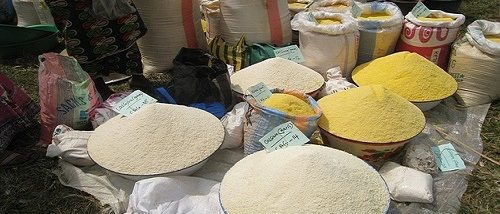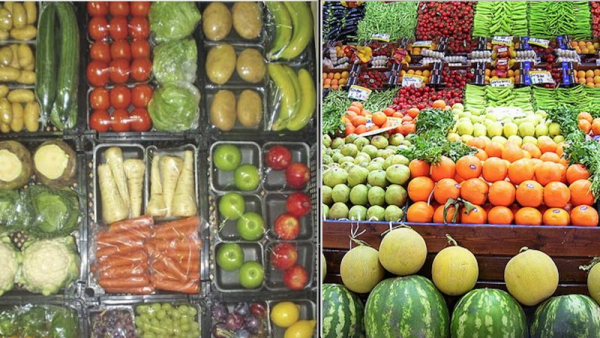How To Export Cassava Granules From Nigeria
 Shippers Guide is the learning page of MMS Plus newspaper. Here you learn the 5Ws and most important ‘H’ on various aspects of shipping. This week, we would take you through a detailed process of garri production, processing and packaging, upto the export stage. Enjoy it:
Shippers Guide is the learning page of MMS Plus newspaper. Here you learn the 5Ws and most important ‘H’ on various aspects of shipping. This week, we would take you through a detailed process of garri production, processing and packaging, upto the export stage. Enjoy it:
Investing in cassava production for export is a thriving business and a money spinning venture.
Cassava Granules popularly known as ‘garri’ is an important food grown throughout Nigeria. It is tuberous and has the ability to thrive in poor soils and has considerable resistance to drought. It is also used to refer to the root of this tropical plant. Garri is seen as readily available raw materials for establishment of small and medium scale industries in Nigeria.
Garri and cassava production in Africa is an impressive business opportunity for the continent, especially West and Central Africa. Cassava is one of the most popular and widely consumed food crops in Africa.
As Africa’s population and economy continues to grow rapidly, the demand for food staples like cassava has increased. This high demand for various forms of processed cassava is pushing prices to the ceiling.
Several small scale cassava farmers are making a fortune and changing their lives through this business. People enjoy eating garri in the form of Eba with soup or soaked in cold water as flakes taken with smoked fish, groundnut or cooked beans, etc.
There are different varieties of garri being sold in the market; you have the red Garri, White Garri and Ijebu-garri.
The difference in these garri products is the production processes used to make them. The red/Bendel garri is produced by adding palm Oil to the already fermented cassava before or during frying to reduce the cyanide content found in cassava.
The White Garri is produced by allowing the grated cassava to ferment for at least three days without adding palm Oil to it. The Ijebu garri is very common in the south western region of Nigeria, usually white and is produced by allowing the grated cassava to ferment for five days before it is fried.
Demand For Garri
Since the return of democratic rule in Nigeria the price of garri suddenly shy rocketed from N700 to N4000 per 50kg bag .This is due to the massive exportation of garri from Nigeria to some West African countries like Ghana, Benin republic, Togo and others.
Producers of Garri
Also, since Nigeria is the largest producer of cassava, countries like China and India have started looking towards Nigeria for their supplies of processed cassava for use as industrial raw materials.
To generate huge income from garri production Business in Nigeria, it is either you start producing garri for local consumption or you get it packaged for export to countries like USA and UK with a large concentration of Nigerians for them to buy and pay you in Dollars and Pound sterling.
Steps to Start producing Garri for Export
So, to start a profitable garri production and Export business in Nigeria here are some of the requirements.
Raw Materials Required
The major raw material need for the production of garri is cassava tuber and like we all know Nigeria is the largest producer of cassava in the World and this means that cassava can be sourced easily from farmers in the rural areas or you can even start a cassava farm of your own to help meet the high demand for garri.
Finance
The capital you need to start your own garri production and export business depends on the quantity you want to produce. The larger the capacity of the plant the more costly it is to setup. Therefore to setup a small scale garri processing plant say of 5Hp plant that is capable of producing install capacity of 5tons of cassava daily, then you need at least N1.8Million Naira.
Equipment Required:
The following are the equipment needed to start garri production business. Cassava grating machine, cassava press, table knife or peeling machine if you can afford one, cassava frying machine, wheelbarrows, plastic or steel basins. All these machines and equipment can easily be purchased from local machine and equipment fabricators in Nigeria.
Production Process
To start the garri production process, the first thing to do is to peel and wash of all the sands and dirt from the body of cassava tubers. After this is done, you can now start to grate the tubers into tiny bits or pulps then bag the wet pulp and then mount the bag in an hydraulic powered jack press to remove water from grated cassava.
After removing the excess water from the cassava pulp you should then allow it to ferment for two to three days but depending on the type of garri you want to produce whether it is white, red or Ijebu Garri. The next stage is to start frying the garri.
Packaging for Export
To make extra income from the garri production business, you need to export your garri to other countries in West Africa, Europe and America. To start the exportation from Nigeria you need to properly package the product to meet the required standard set by the particular country you are sending it to.
The great demand for garri in Nigeria and abroad has made the production of garri a very profitable business for whoever is interested in starting a business with high return on investment.
Establishing the Cassava processing plants
The plants and machinery for setting up of the cassava chips and pellets, industrial starch and flour, ethanol, garri and foo-foo producing and packaging plants for both locally and export markets are locally available. However, arrangements can be made for foreign machines on request. There are foreign machines from China, South Korea, Japan, India etc.
The raw materials, labor and all other required inputs are locally available. All other essential details including accommodation, manpower, production technology and packaging.
Production
Nigeria is a major producer of this tropical crops with output conservatively put at over 50, 000 metric tons. Cassava and its allied products were on the export prohibition list for quite long time. From 1996, its ban was lifted. With this policy action, Nigeria exporters were given the opportunity to develop export markets for this product.
Apart from Nigeria other major tropical developing countries that produce cassava include Brazil, Thailand and Indonesia. Nigeria over 60,000 metric tons of cassava is almost totally processed and consumed locally.
Export types
Cassava for export includes dry cassava leaves, chips & pellets, starch and ethanol. All these products can be exported and very lucrative business.
Export
Globally, only 15 percent of total production of cassava is exported with Thailand being the major exporter of cassava products. As earlier stated cassava and its derivatives were delisted from the export prohibition lists since 1996 and any Nigerian can invest and export any processed product(s). Its export is now encouraged among other food crops for which Nigeria is a major producer by the present administration.
Global Markets
The direction of cassava export is mainly Europe and North America with European Union accounting for about 90 percent of the total buyers. About 30 percent of cassava production globally is used for starches and other industrial products and only less than one percent is processed into ethanol particularly in Brazil. It is a choice animal feed material because of its high carbohydrate content. It is however mixed with protein sources such as Soya beans.
European Market Overew
Europe is the major importer of cassava for animal production. Animal production being the main attraction of Agriculture in Europe, accounted for about 70 percent of total agricultural output. The compound feed formulation is the main attraction for cassava. About 90 percent of the traded cassava in Europe is from developing countries, Such as Nigeria. Main suppliers are Thailand (about 85 per cent), Indonesia (about six percent), sub Saharan Africa is yet to contribute significantly to world trade in cassava with about three (3) percent recorded in the early part of the millennium.
The principal buyer of cassava in Europe is Netherlands, (accounting for over 40 percent of total Europe imports); Germany (about 20 per cent), Belgium and Luxembourg (about 13 percent), France (eight percent), U.K (10 percent) and Italy (two percent).
Transportation and Handling
Transportation and handling constitute high levels of cost of inputs in preparation of garri for export. This is due to the bulky nature of the product. This cost could be as high as 50 per cent of total cost.
Proper management of the cost reduction programme is therefore recommended for those who wish to venture into the export of cassava/ garri as reduction of costs will afford better competitiveness. Cassava pellets are usually cheaper to transport and handle than other exportable processed cassava products like industrial starch. The standard of the product is very important.
Quality Standards
Feed millers are very critical about quality. Consistency of quality is very important for them to maintain the standards of their products.
Quality is usually in terms of nutritive value. Minimum standard specifications are as follows 70 percent, 70 percent and 62 percent stand for chips, flour and pellets respectively while moisture content is 14 percent, fiber five percent and ash-three percent content for all the three products.
Chips are normally white or near white, clean, free of mould, foreign matter insect damage and without odors. Length of chips should be 4-5mm. It should be noted that if the quality standard is not maintained the export project is bound to collapse. Therefore must be worked out carefully.
Global Packaging Requirements
Packaging is done in sacks of cotton, multi-craft paper bags or clean jute bags or woven sacks; pellets should be uniform in shape and size, less fragile and should be compatible for handling, storage and transportation. Palletizing equipment exists for production of pellets. Prospective investors should not be afraid of the quality control because the writer through years of experience can guide any investor to success.
Prospective investors can start very small and gradually grow. The proposed project is always very lucrative.







